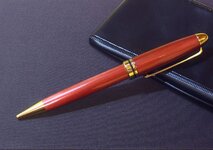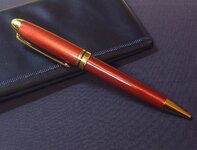underdog
Member
Couldn't wait for my other kits to come in, so I put this Metalic Red acrylic from Exotic Blanks on a TN Gold Euro kit. Not as crazy about the color as I was about the purple one- too monochromatic. Still it looks nice. I just realized that it's only my second Euro pen too. Did the first one years ago for my sister... This one went ok considering I haven't turned any recently...
I even got this one concentric on a mandrel! Must be my cheapo bushings on the comfort/slimlines making everything out of round.
Must be my cheapo bushings on the comfort/slimlines making everything out of round.
Took me forever to turn it down though. This metalic red blank appeared to be a lot more brittle than the madreperlato purple. But still...
What's the secret of turning this stuff fast? I don't see how Ed can get any blank on and off the lathe in five minutes...
I even got this one concentric on a mandrel!
Took me forever to turn it down though. This metalic red blank appeared to be a lot more brittle than the madreperlato purple. But still...
What's the secret of turning this stuff fast? I don't see how Ed can get any blank on and off the lathe in five minutes...


